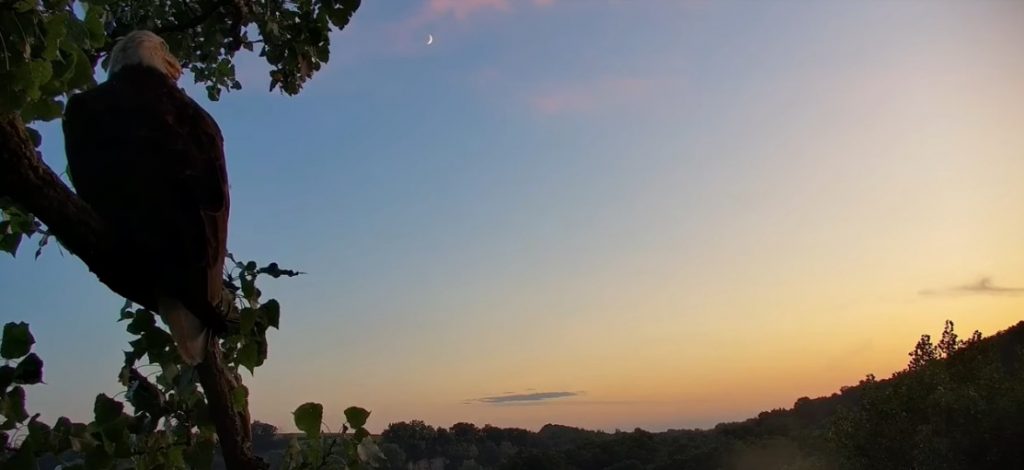I’m reading “Flight Ways: Life and Loss at the Edge of Extinction.” The first three chapters inspired some afternoon #musing.
Place, as writer Thom Van Dooren points out, can be understood as an embodied, lived, and meaningful environment. Bald eagles clearly have a sense of place. Their territories are woven with layers of attention, meaning, and experience: spots to hunt, perch, and hide from the weather, materials to build and replenish their nests, and mates and family to bond with and care for. Eagles have neighbors beyond counting – squirrels, mice, raccoon, rabbits, muskrat, mink, coyotes, deer, prairie dogs, trout, catfish, suckers, turtles, frogs, people, and many species of birds, just to name a few of the vertebrates – that can be symbiotes, dinner, intruders, competitors, and even companions, depending on the situation, the time of year, the location, and the species. Eagles have much to keep track of.
While instinct is a significant part of eagle behavior, the word implies that they are passively experiencing the places they inhabit: something happens to them and they respond to it. But it is hard to believe that eagles don’t also connect actions with causes and outcomes, especially when our observations show them actively interpreting and influencing their surroundings. We’ve watched eagles prune sticks from favorite flyways and perches, clear site lines, strip bark from branches targeted for removal, and take advantage of food resources in unexpected ways. They have food preferences, distinct bonding styles, unique behaviors, and even personalities. When watchers look into our nests, they see something of themselves looking back.
Bald eagle studies done before the species’ decline found that they were quite cautious of human beings: unlikely to approach them and easily disturbed. While that may still be true of some bald eagles, especially those living in remote areas, the opposite seems to be true of most eagles. They came back to a landscape full of people that held very different attitudes about birds of prey. Eagles habituated individually and generationally, so that eagles now nest over bike trails in Decorah, behind apartment buildings in Minneapolis, and near automobile plants in Chicago. The plight of bald eagles changed people’s minds about bald eagles, which changed bald eagles, which changed people’s minds about bald eagles even more. That is a very complicated story: an entangled state of becoming, as theoretical physicist Karen Barad puts it. The Oxford Dictionary defines a landscape as all the visible features of an area of countryside or land. But our eagles live in a place with all that word implies: history, meaning, entangled stories, entangled existences, and complex lives.
Do bald eagles have internal lives and intelligence? They experience many of the behaviors we see in birds like crows, which are renowned for their intelligence: language, delinquency, insight, emotion, frolic, passion, wrath, risk taking and awareness. Eagles organize in social multi-age groups away from their territories, follow consistent migration paths between winter and summer grounds, select and retain mates, build large, complex nests, incubate and brood young in challenging conditions, teach their young, learn from life events, and recognize and remember things on their territories. Eagles don’t live on a landscape, they live embedded in a place. Eagles have internal lives and intelligence, and eagles know who they are.
Traditional biological science insisted that researchers think about animals in very limited ways. Since science didn’t recognize animal intelligence or emotional capacity, researchers were encouraged to think of animals as automatons: machines that perform functions according to a predetermined set of coded instructions. I believe that our unwillingness to recognize the internal lives of animals was a failure of imagination and observation that was anthropomorphic in its own right. Instincts – all animals, including human animals, have them – do not preclude intelligence. Non-human intelligences might not think, reason, or feel like us, but they still think, reason, and feel.
When is anthropomorphism wrong? In thinking about animals, we need to respect that their emotions and intelligence might look very different from ours. We need to enter their Umwelt: their experiential world of sight, sound, feel, taste, desires, wants, needs, and even histories. Failing to do so is disrespectful to our fellow travelers and can have disastrous consequences to them and to us.
I’ll close with a quote from the third chapter of Flight Ways. “At this time in Earth’s history, there are numerous different paths to extinction, numerous ways to end the possibilities of life for generations of a kind. For many creatures, for many populations and species, it is the loss of an important place that leads inexorably to their own end…Perhaps the very least we can do is learn a sensitivity to the storying and place-making practices of these non-human others, a sensitivity that just might provide an avenue to more sustaining possibilities of life, across species and across generations.” Your willingness to learn the stories of birds and their places gives me hope for the future. Thanks for watching, sharing, learning, and especially caring with us. Let’s do our best to enter their world – and the worlds of all the animals we watch – by asking a very important question: Who are you?



